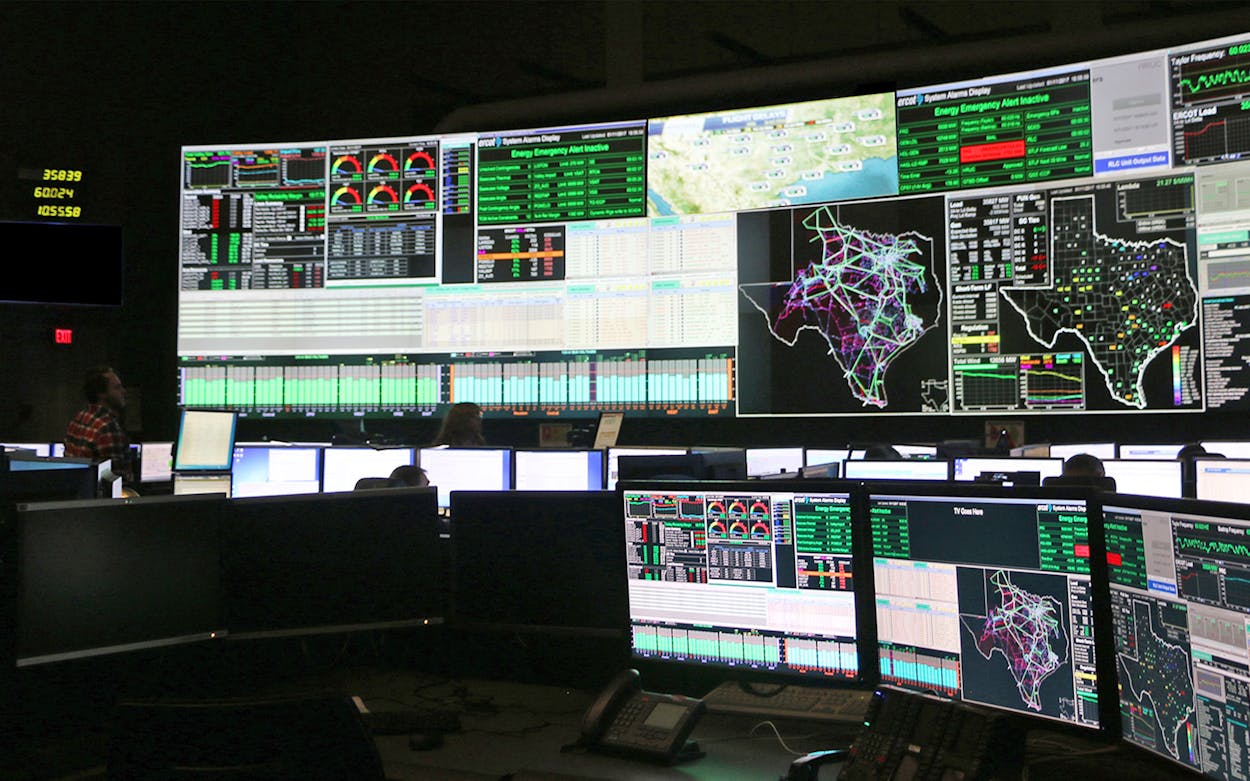On Thursday afternoon and Friday morning, reporter Jeffrey Ball talked to Bill Magness, the president of the Electric Reliability Council of Texas, ERCOT, the grid operator at the center of the Texas blackouts.
This interview has been condensed and edited for clarity.
Texas Monthly: To what extent was what happened this week a result of the system’s reliance on intermittent renewables, particularly wind versus gas and coal?
Bill Magness: What this storm showed is that, when you have a once-in-however-many-years storm like this in Texas and it covers the entire state with single-digit temperatures and freezing precipitation and ice, it affects every type of generation. Wind-turbine blades ice over for several days. You get a lot less out of solar when the polar-vortex-type winds blow through. And then, also, gas-supply issues arise when you have that kind of cold. So, then, if the natural-gas plant is having trouble getting fuel, that’s a problem. We saw coal plants have trouble. We really saw across the resource portfolio, it was just really the nature of the storm this time.
TM: Federal officials warned Texas following the winter 2011 blackouts that they should do more to require generators and gas producers to winterize their facilities. What did ERCOT do as a result of that recommendation?

BM: We would visit some of the generators. It wasn’t a conversation like, “I’m your regulator and you have to do this.” It was more sharing those best practices. And I think we really saw some results of it in 2018 when we had what used to be our winter peak demand. The temperatures were similar to 2011. But we had much better results. We got over the peak. There was no bloodshed. Whether that was all attributable to weatherization efforts, impossible to say. But I think you do see some evidence that the approach had some results.
TM: Should the Texas Legislature mandate weatherization?
BM: I think it’s important for the Legislature to consider it. I mean, that’s a policy decision for the Legislature to make. And I think the reviews of this event are going to inform that. What the costs with the benefits are will inform that. But I think you’d need to really understand what happened in the event. And that’s still something we’re going to have to gather up once we’re finished getting all the people back their power.
TM: Texas doesn’t require its power generators to have generating capacity ready to provide in an emergency. Should it?
BM: The capacity market versus the energy market has been debated very actively, with those debates happening at the PUC [Public Utilities Commission] and at the Legislature. I think that’s where they appropriately should, because there are debates about who pays what and how costs are allocated. If you require extra of something, and it’s paid when it isn’t producing, it’s paid-for capacity, then somebody is paying for that.
TM: Isn’t that true too of a weatherization requirement?
BM: As you reference, it is sort of similar. It’s a question of cost-benefit. And that’s where policymakers decide if it’s winterization that’s going to solve my problem and I’m willing to pay for it. Is it worth the cost to consumers to impose these requirements? They’re going to have to ultimately pick up those costs.
TM: To what extent does ERCOT consider whether and how climate change might be intensifying the severity of storms, even in the winter, that affect the grid?
BM: We don’t have any climate specialists on staff. We have a meteorologist who looks, but looks more at what’s coming at us on the grid and does forecasts of various lengths. That’s a different field than climate science. We measure how we think we’re going to do, and do we have enough by what we’ve seen, or models of what we could see. But most of it is empirical. Most of it is, “What’s the most-severe weather event we’ve seen that we need to be prepared for?” That’s what was, at least as of this week, pretty shocking about what we saw this week. Obviously, February 2021 is going to be a new marker for what we can see, and it will have to be worked into our models in the future.
TM: Should ERCOT do more to consider the potential effects of climate change in its forecasting?
BM: We certainly do forecasting, and we take into account what our forecasters believe makes sense, whether it’s from weather, from economics, and various factors when we do longer-term planning. As we see things, we try to add relevant factors. And I think, again, if it’s just to look at anything differently, we’ll discuss that as the after-action report and investigations are undertaken.
TM: Did the power supply in states neighboring Texas fare better than the ERCOT grid? And if so, why?
BM: We haven’t had a chance to look much further than Texas. If there’s lessons learned from any of our neighboring power areas, it’s something we’ll certainly look at and try to improve from.
TM: Is there anything we didn’t discuss that you’d like to address?
BM: We understand this is a horrible event for the state that took much longer to get out of than we or anyone else wanted. It’s been very difficult. The action that we took, at its core, was to preserve the integrity of the grid so we would not lose this grid; so we wouldn’t explode turbines and other kinds of issues that can arise if you let the grid get too out of balance; to prevent that catastrophic blackout. At least today we can say we’re very close to seeing these outages ending.
- More About:
- Politics & Policy
- Winter Storm 2021






